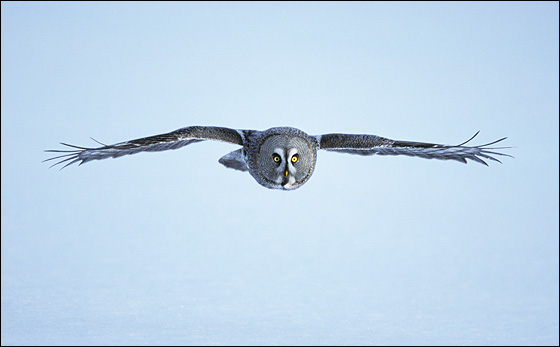Great Grey Owl (Strix nebulosa)
An alarmed Great Grey Owl stretching itself up as high as it will go, with its feathers fluffed out and its yellow eyes offering a determined stare, is a pretty formidable sight. Its feats of daring are impressive, too, with regular reports of these birds banishing mighty Goshawks from their territory, and even attacking bears in defence of their nest. Yet, if you look below the surface the Great Grey Owl’s act is a triumph of style over substance. The birds themselves are quite lightweight, only half the weight of the comparably sized Eagle Owl, and the only animals that they routinely terrorise are voles.
Despite their ability to catch prey in snow, the prey needs to be there in the first place, and some birds are forced to move around semi-nomadically following the vole populations. As a result these birds may change partners from year to year, and they might also practise what could only be described as speed-dating, pairing up a mere two weeks before egg laying. The nests are usually placed in the abandoned structures of other birds such as Sparrowhawks and Buzzards.
These are birds of the far north, where their prime habitat consists of lichen-sprinkled spruce and pine forests, especially those adjacent to clearings or other open areas. Some birds remain on their territory all year, and they have a very special talent that enables them to survive, even when their patch is under deep snow – they can detect small mammals entirely by sound. The birds hover over the smooth snow, listening, and then, “clenching” their talons, they drop down, smash through the crust, and grab their prey from as much as 45 cm below the surface. When using their more normal feeding technique, perch and pounce, they are able to detect and strike at prey from 100 m away.
Despite their ability to catch prey in snow, the prey needs to be there in the first place, and some birds are forced to move around semi-nomadically following the vole populations. As a result these birds may change partners from year to year, and they might also practise what could only be described as speed-dating, pairing up a mere two weeks before egg laying. The nests are usually placed in the abandoned structures of other birds such as Sparrowhawks and Buzzards.

